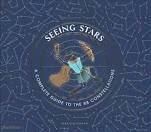
Seeing Stars: A Complete Guide to the 88 Constellations
by Sara Gillingham
523.8 Gil
New Arrivals Island, 2nd Floor
Now that the evenings are not as frigid as just a few weeks ago, there is a little less rush when taking out the trash, and more of an inclination to glance up at the clear night skies. The possibility of nights around a fire pit gazing at the stars becomes a more likely prospect. Dreams of summer evenings have inspired me to become familiar with more constellations than the Big Dipper.
This addition to the Curriculum Collection is a well-designed introduction for upper elementary through high school audiences – as well as the rest of us! It introduces 88 ancient and “modern” constellations, with notes about cultural or historical origins. Gillingham gives each constellation its own consistent spread: diagram, location description, how to find it and when, and a brief introduction to stories and myths associated with it. The facing page includes the diagram with illustration of the figures.
As to be expected from a solid, engaging non-fiction selection for preK-12, the appendix contains additional research resources. I have always found it challenging to see shapes in the stars, so I will be downloading one of these two recommendations, apps which allow me to point my phone at the night sky and identify constellations:
A search of Research@UWW (Books, Media & More) results in other tempting titles for young readers and researchers, including another juvenile non-fiction title:
Space! / senior editor, Ben Morgan ; contributors, Robert Dinwiddie [and 5 others].
e-books for adult readers:
First magnitude a book of the bright sky / James B. Kaler.
Stargazing for dummies by Steve Owens.
an activity guide from the National Park Service:
Junior ranger, night explorer : an explorer’s activity guide for ages 5 to 12.
and streaming video selections:
Constellations / A&E Television Networks, LLC.
Look it up, look up, and enjoy!
